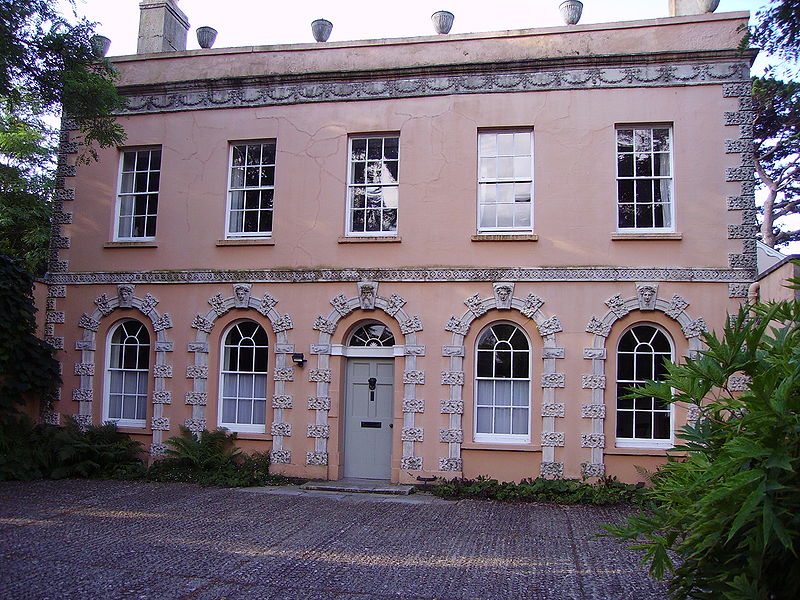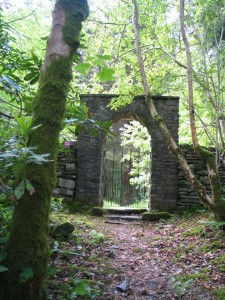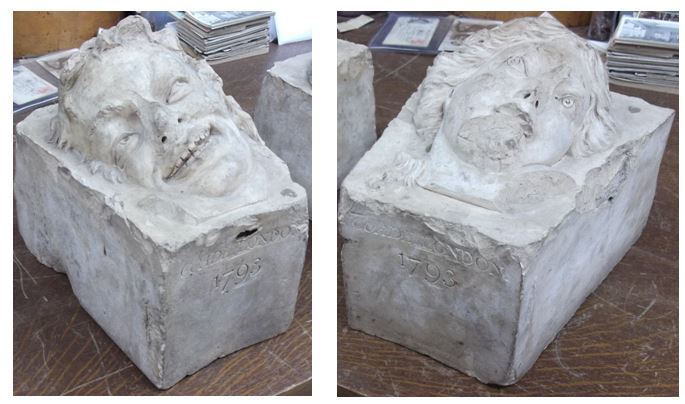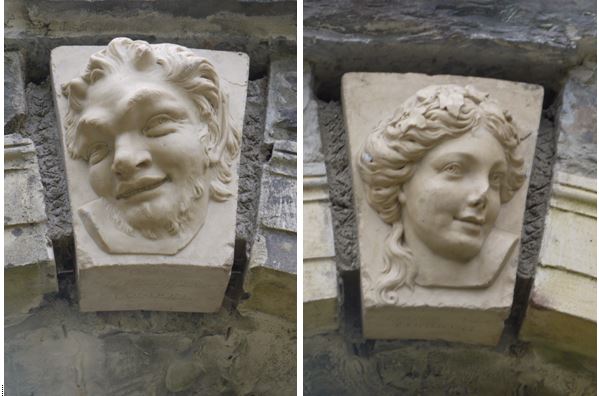by The Curious Scribbler
In its heyday the arched doorways through the drystone wall of Mrs Johnes’s garden at Hafod were each embellished on the garden side with rusticated dressings with a keystone depicting a stone head: a mischievious male face – a Satyr, and a gentle female visage, – a Nymph. These must have looked down upon Mrs Johnes, her guests and her gardeners as they passed out of the garden, towards the Peirian Cascade or along the Lady’s Walk beside the river Ystwyth.
As the garden reached its nadir of dereliction after the demolition of the mansion, and the driving of a forestry road through the garden walls, someone ‘rescued’ these keystones, and for many years they resided in the private collection of Margaret Evans, parts of whose hoard of costume, artefacts and memorabilia used to be displayed in the Railway station building in Aberystwyth. Many fragments of masonry from Hafod migrated during these years, some to nearby garden features and rockeries, others to the hands of descendents of former owners and tenants of the Estate.
But Hafod, even at its most neglected, retained its fascination for those who knew it. One of the earliest projects generated by local enthusiasts, the Friends of Hafod, led to the repair and repointing of the damaged arches. Margaret Evans remained fierce custodian of the keystones so the restoration involved the insertion of a pair of modern moulded concrete heads in place of the missing originals. The heads were male and female faces, and the garden, still lost in the forestry plantation, became known locally as the Adam and Eve garden.
Another Hafod enthusiast persuaded Margaret Evans to allow casts to be made of the original heads in her collection, and a replica pair were made. The interest of the originals is considerable for they are made of a ceramic artificial stone, “ Coade Stone” invented and marketed by Miss Eleanor Coade and dated 1793. Much of the ornamentation of London’s Georgian buildings and many well known statues are of Coade stone, a marvellously durable material little weathered by the passing years. Mrs Coade called her invention ‘Lithodypyra’ literally meaning twice-fired stone. It was a very skilled process to get the firing temperatures prolonged and correct in the kilns of the day. A fine example of Coade stone ornamentation is at Belmont House, Mrs Coade’s country home at Lyme Regis where nymph keystones adorn the ground floor windows.

Belmont House, Eleanor Coade’s country house in Lyme Regis is elaborately ornamented with her patent Coade Stone
The Coade stone heads had suffered a good deal from their time in the neglected garden and the nymph in particular had lost a substantial portion of her chin. The casting process gave the opportunity to do some facial reconstruction and the handsome facsimile casts, fashioned in a modern resin, are crisper and more perfect than the originals. They were held in the collections of the Friends of Hafod.
The decades rolled on and both Mrs Evans’ collection and the Friends of Hafod collection found their way eventually to the custody of the Ceredigion Museum. Almost an embarrassment of riches, for the Museum thus held both the original and the facsimile heads. It has been a happy co-incidence that the serious restoration of Mrs Johnes’s garden has allowed the installation of the high quality facsimiles in the place of the original keystones. The many visitors who passed through the gates last weekend entered beneath the gaze of the very characters which once looked down on Mrs Johnes.





Hi,
After reading your fascinating report about the nymphs that hung from the garden arch, I was very curious to find out weather the original stones were ever found?
Look forward to hearing from you
Yes, the original Coade stone heads are in the Ceredigion Museum, Aberystwyth
Thank you for your prompt reply regarding the coade stone heads. The reason for my curiosity is that in 1992 my mum moved into a property in Southampton and unearthed a very mischievous little chap in the shape of a keystone. On the bottom the words coade Lambeth 1707 are inscribed. This got me to wondering where he had originated.
It sounds as if your mother has found an original Coade stone keystone. Assuming that is, that you made a typo on the date – it was perhaps 1770 not 1707? ( Eleanor Coade only bought the business in 1769). But Coade, Lambeth is correct. They were produced in some quantities from a mould, so other gardens than Hafod have got one. they crop up from time to time in architectural antiques auctions – so your mother has quite a find!
Two further heads existed over the 18feet tall doors of Hafod. These were 2 putti looking in towards the doors. I don’t think these are coadstone, they look more like limestone to me but I’m no expert. I have never seen any numbers on mine. One of these migrated to the 1950’s extension of my cottage. One of the previous owners of my cottage was the daughter of a well known local artist Gladys Vaisey. Her daughter was friendly with a chap who had been a gardener at Hafod and he liberated my putti from the demolition rubble so the story goes. The whereabouts of this head was well known to the School of Art, Aberystwyth where my late husband used to work. Quite recently I was approached by the Friends of Hafod for the return of the head, but as is part of my bedroom wall I had to decline. However, I was also in possession of 2 grave stones from the pet cemetry, one of which was found under the kitchen floor during renovations in 1995. These I have gladly returned to Hafod. They comemmorate the lives of two horses.
Thanks for your memories. The gravestones are now in place near the gate from the stables to the mansion site. How do we know why were horses? If so they died remarkably young.
I’m sure you are not alone in having a little bit of Hafod built into your property. I’m planning to do a blog about some such fragments, perhaps we could include your putto then?
I was told ,or rather my late husband was told by the School of Art that they were horses, we had always assumed they were dogs. Sometime ago now ,an old gentleman turned up at my door with a bundle of papers concerning Hafod which he gave to me, he also referred to them as horses gravestones. However without the benefit of the bodies we will never know for sure I suppose.
Pingback: Artificial Stone 2: Eleanor’s enterprise | Parks and Gardens UK